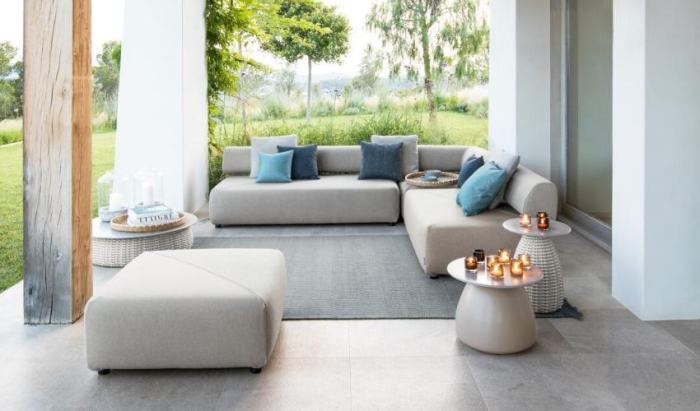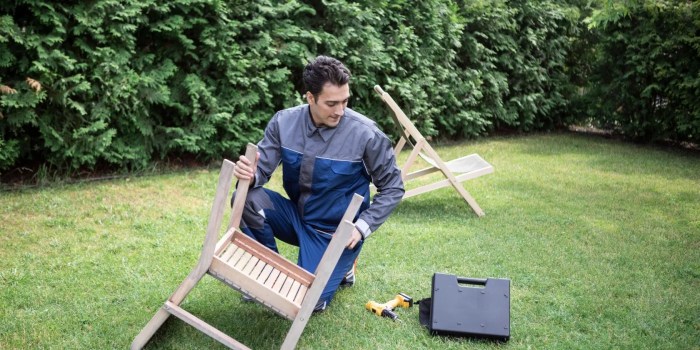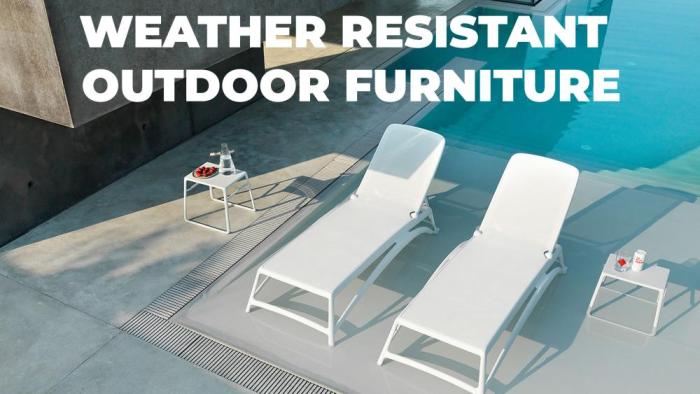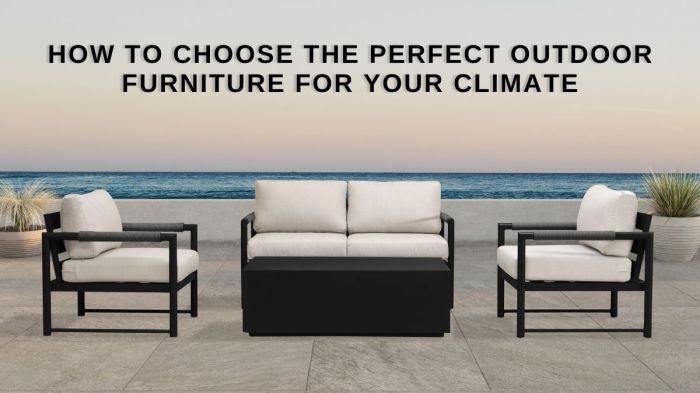How to choose outdoor furniture that resists fading and weather? This guide is your ultimate companion in navigating the vibrant world of outdoor furniture, helping you select pieces that withstand the elements and endure the test of time. From understanding the strengths and weaknesses of various materials to recognizing the crucial role of built-in protection, you’ll gain valuable insights into creating an outdoor haven that stays stylish and functional year after year.
Let’s dive in and explore the secrets to choosing furniture that truly lasts!
Choosing furniture that resists fading and weather is more than just aesthetics; it’s about long-term investment. This comprehensive guide explores different materials, their unique vulnerabilities and advantages, and how to combat the damaging effects of sun, moisture, and temperature fluctuations. We’ll delve into the world of protective coatings, explore maintenance strategies, and equip you with practical tips for making the right decisions.
Ready to transform your outdoor space into a timeless retreat?
Understanding Outdoor Furniture Materials
Choosing outdoor furniture is a gamble against the elements. Just because something looks great in the showroom doesn’t mean it’ll still look fantastic after a summer of sun and rain. Understanding the materials used is crucial to making an informed decision, so let’s dive into the world of outdoor furniture materials.
Wood
Wood, with its natural beauty, is a popular choice for outdoor furniture. However, its inherent vulnerability to moisture and sun exposure necessitates proper care. Different wood species vary in their resistance to decay and rot. Hardwoods like teak and ipe are renowned for their durability, often requiring less maintenance than softer woods. However, even these need regular sealing and refinishing to maintain their appearance and prevent premature deterioration.
Properly treated and maintained, wood furniture can last for decades.
Metal
Metal furniture, particularly aluminum and stainless steel, stands up remarkably well to the rigors of the outdoor environment. Its high resistance to rust and fading makes it a top contender. Aluminum, for example, is lightweight and easy to maintain, requiring only occasional cleaning and a touch-up of paint to preserve its shine. Stainless steel, while a bit pricier, offers exceptional longevity and requires minimal upkeep.
These metals are a solid investment for those seeking long-lasting outdoor furniture.
Plastic
Plastic outdoor furniture is often the most affordable option. However, its resistance to fading and weather is generally moderate. While it’s easy to clean, plastic furniture is often more susceptible to fading and cracking in intense sunlight. Choosing high-quality, UV-resistant plastic can extend its lifespan, but its durability isn’t as high as some other materials. Plastic furniture is best suited for light use and less demanding outdoor settings.
Wicker
Wicker, often made from synthetic materials like polyethylene or polypropylene, provides a charming, natural look for outdoor furniture. Its moderate fading and weather resistance can vary greatly depending on the quality of the material and the weaving. Proper care, including regular cleaning and occasional repairs, can significantly extend the lifespan of wicker furniture. It’s a good choice for those looking for a stylish yet somewhat low-maintenance option.
Resin
Resin, a composite material, offers a compelling combination of durability and aesthetic appeal. Resin furniture is generally resistant to fading, moisture, and other environmental stressors. Its smooth, non-porous surface makes it easy to clean and maintain. High-quality resin furniture can rival or even exceed the longevity of wood and metal, providing a sturdy and visually appealing option for various outdoor settings.
Material Comparison Table
| Material | Fading Resistance | Weather Resistance | Maintenance |
|---|---|---|---|
| Wood | Moderate | Moderate | Regular sealing and refinishing |
| Metal | High | High | Regular cleaning and occasional painting |
| Plastic | Low | Moderate | Easy cleaning |
| Wicker | Moderate | Moderate | Regular cleaning and occasional repair |
| Resin | High | High | Easy cleaning |
Factors Affecting Fading and Weathering

Outdoor furniture, while a delightful addition to any patio or garden, faces constant battles against the elements. Understanding these battles is key to choosing furniture that’ll withstand the test of time, looking fabulous and functional year after year. Think of it as a superhero showdown, but instead of saving the world, your furniture is saving your sanity from constant replacements.The relentless forces of nature can wreak havoc on even the most robust outdoor furniture.
From the scorching sun to the relentless rain, understanding how these elements interact with different materials is crucial to making informed choices. Knowing your furniture’s Achilles’ heel, like a superhero’s weakness, will allow you to choose the right defenses against the outdoor elements.
Key Environmental Factors
Sunlight, moisture, and temperature fluctuations are the three primary environmental factors impacting outdoor furniture longevity. Imagine these elements as three mischievous sprites, each with their own destructive powers. Sunlight, with its powerful UV rays, is the sprite that causes fading and discoloration. Moisture, in its various forms, can lead to mold, mildew, and rot, like a tiny army of microscopic monsters.
Finally, temperature fluctuations put stress on materials, causing cracking and warping, like a playful but destructive game of tug-of-war.
Sunlight’s Impact on Fading
Ultraviolet (UV) radiation is the primary culprit behind color degradation. Sunlight contains a spectrum of radiation, and UV rays are the ones that penetrate the surface and cause the pigments in the material to break down, resulting in fading. Think of it like a slow, insidious chemical reaction. Materials with poor UV protection are like candy in the sun – they quickly lose their vibrancy.
Using UV-resistant materials is essential to keeping your furniture looking its best. For example, a vibrant red patio set left unprotected in a sunny climate will likely lose its color faster than one made from a UV-resistant material.
Moisture’s Role in Degradation
Moisture, in all its forms – rain, dew, or even high humidity – can be detrimental to outdoor furniture. Water, especially when it sits stagnant, can lead to the growth of mold and mildew, which can cause discoloration, and ultimately rot the material. The combination of moisture and fluctuating temperatures creates an ideal breeding ground for these nasties.
This is especially important for wood, wicker, and fabric furniture. Consider a material’s water resistance when choosing your furniture. For instance, a wooden deck chair left out in a humid climate might succumb to mold and rot faster than one made of a moisture-resistant material.
Temperature’s Impact on Durability
Temperature fluctuations put stress on materials. Extreme heat can cause materials to expand and contract, leading to cracking and warping. Similarly, cold temperatures can cause brittleness and weaken the material, making it more susceptible to damage. Different materials react differently to temperature changes. For instance, plastic furniture might crack in extreme heat, while metal furniture might rust or warp in fluctuating temperatures.
Consider how the temperature in your region varies throughout the year when selecting furniture.
Correlation Between Weather Conditions and Furniture Damage
| Weather Condition | Effect on Furniture | Fading Risk | Durability Impact |
|---|---|---|---|
| High Sunlight Exposure | Increased fading and discoloration | High | Reduced |
| High Moisture | Increased risk of mildew and rot | Moderate | Reduced |
| Temperature Fluctuation | Stress on materials, potential cracking | Moderate | Reduced |
This table highlights the correlation between various weather conditions and their effects on outdoor furniture. Understanding these factors is essential to selecting furniture that can withstand the specific challenges posed by your local climate.
Choosing Furniture with Built-in Protection: How To Choose Outdoor Furniture That Resists Fading And Weather

Tired of your outdoor furniture looking like a faded, sun-bleached victim of a rogue weather system? Fear not, intrepid patio-dweller! Investing in furniture with built-in protection is like giving your outdoor set a super-powered shield against the elements. It’s a smart move that will save you from the constant battle against sun damage, rain, and the general mayhem of Mother Nature.Protecting your outdoor furniture is no longer a battle of attrition.
Choosing pieces with inherent protective treatments is a proactive approach, transforming your outdoor space from a potential damage zone to a vibrant, enduring oasis. These treatments, often invisible to the naked eye, work tirelessly behind the scenes to safeguard your furniture investment.
Furniture with Inherent Protective Coatings
Many modern outdoor furniture pieces are crafted with built-in protective coatings. These coatings form a barrier against the elements, preventing damage from UV rays, moisture, and general wear and tear. Think of it as a shield, subtly applied, making your furniture more resilient and resistant to the outdoor elements. These coatings are often applied during the manufacturing process, so you don’t have to worry about additional application and maintenance.
The Role of UV Inhibitors and Weather-Resistant Finishes
UV inhibitors are like tiny solar shields, strategically placed within the furniture’s materials or finishes. They actively combat the damaging effects of ultraviolet radiation, preventing the fading and discoloration that sun exposure can cause. Weather-resistant finishes are the furniture’s armor, creating a barrier that keeps moisture and other elements from penetrating the materials. These finishes work in tandem with UV inhibitors, providing comprehensive protection.
Essentially, these combined elements are the secret weapon of weather-resistant outdoor furniture.
Examples of Furniture Designs with Built-in Weather Protection
Consider furniture made from materials like teak, aluminum, or composite materials like WPC (wood-plastic composite). These materials often inherently resist fading and weathering. For instance, teak, renowned for its natural oils, provides a natural defense against the elements. Aluminum frames, with their inherent resistance to rust and corrosion, are another excellent example. WPC furniture, a composite of wood fibers and plastics, offers a balance of natural beauty and durability, with excellent weather resistance.
Importance of Inspecting Labels and Certifications for Weather Resistance
Don’t just rely on looks! Look for labels and certifications that guarantee the furniture’s weather resistance. These certifications are your assurance that the furniture has undergone rigorous testing and meets specific standards for outdoor use. This information is your key to understanding the level of protection you’re getting. Check for certifications like the ones issued by independent testing organizations, such as the American Society for Testing and Materials (ASTM).
Factory-Applied Finishes vs. DIY Treatments
Factory-applied finishes are often superior to DIY treatments. Factory applications use specialized equipment and processes that ensure a uniform and long-lasting protection. DIY treatments, while sometimes cost-effective, can be inconsistent and may not provide the same level of protection over time. Think of it as a professional versus a home-brewed remedy. The professionals have the equipment and expertise to create a superior product.
Maintaining Outdoor Furniture

Keeping your outdoor furniture looking spiffy and enduring the elements requires a little TLC. Think of it as a spa day for your patio pals! Proper maintenance not only extends the lifespan of your furniture but also prevents costly repairs and replacements down the line. Plus, who wants a patio that looks like it’s been through a war?A well-maintained outdoor set is a happy set! Regular cleaning and protection from the elements are key to preserving your investment.
Following a simple routine will keep your furniture looking its best, year after year.
Cleaning Strategies for Various Materials
Different materials require different cleaning approaches. Just like you wouldn’t use a power washer on your delicate silk scarf, you shouldn’t treat your teakwood table the same way you treat your aluminum chairs. The table below provides a handy guide for each material.
| Material | Cleaning Method | Maintenance Schedule | Specific Tips |
|---|---|---|---|
| Wood | Gentle scrubbing with a mild soap and water solution. Avoid harsh chemicals or abrasive cleaners. | Monthly cleaning, annual sealing. | Use a wood-specific sealant to create a protective barrier against moisture and dirt. |
| Metal | Washing with a mild detergent and water solution. Rinse thoroughly to prevent residue build-up. | Quarterly cleaning, annual painting or application of rust inhibitor. | Use a rust inhibitor if the metal is prone to rusting, especially in humid or coastal areas. |
| Plastic | Spot cleaning with a mild detergent and water solution. Avoid harsh scrubbing, as it can scratch the surface. | Weekly spot cleaning, quarterly deep cleaning. | Use a soft cloth and gentle pressure to prevent scratching. |
| Wicker/Rattan | Gentle brushing or vacuuming to remove dust and debris. Avoid harsh chemicals and water pressure. | Weekly dusting, quarterly deep cleaning. | Use a soft-bristled brush or vacuum attachment to clean between the weaves. |
Protecting from the Elements
Outdoor furniture is designed to withstand the elements, but prolonged exposure to harsh conditions can still take its toll. Think of it like a superhero who needs their suit of armor.
- Rain Protection: Cover your furniture when rain is anticipated. A waterproof cover is your best friend in these situations. This prevents water damage and mold growth.
- Snow Protection: Snow can weigh down furniture, especially if it’s not properly supported. Remove any accumulated snow to avoid potential damage.
- Extreme Temperatures: Sudden temperature fluctuations can cause expansion and contraction in materials like wood and metal, leading to warping and cracking. Try to avoid leaving furniture exposed to direct sunlight for prolonged periods. Consider storing furniture indoors during extreme heat or cold spells.
Regular Inspections
Regular inspections are crucial for catching potential problems early. A little vigilance can save you a lot of heartache and expense later.
- Check for Damage: Look for any signs of damage, such as cracks, splinters, or rust. Address any issues promptly to prevent further deterioration.
- Assess Wear and Tear: Pay attention to any signs of wear and tear, such as loose screws or damaged cushions. Repair or replace these components before they become major problems.
Storing Outdoor Furniture for the Off-Season
Proper storage is essential for preserving your outdoor furniture’s longevity. Think of it as a retirement plan for your patio furniture.
- Clean Thoroughly: Give your furniture a final cleaning before storing it. This removes any accumulated dirt or debris that could cause damage during storage.
- Dry Completely: Ensure the furniture is completely dry before storing it. Moisture can lead to mildew or rot. Air dry thoroughly, or use a drying agent if necessary.
- Cover Appropriately: Use waterproof covers to protect the furniture from dust, moisture, and insects. Proper covers will keep your furniture looking brand new.
- Store in a Dry Location: Avoid storing furniture in damp or humid areas. A garage or shed with good ventilation is ideal.
Practical Tips and Recommendations
So, you’re ready to conquer the great outdoors with furniture that’s as tough as a mountain goat and as stylish as a flamingo? Excellent! Choosing weather-resistant outdoor furniture is less about wizardry and more about savvy shopping and smart placement. Let’s dive into practical tips and recommendations that’ll help you snag the perfect patio set, picnic table, or hammock haven.
Selecting the Right Materials
Outdoor furniture materials vary widely in their ability to withstand the elements. Some are naturally resistant, while others require special treatments. Knowing the strengths and weaknesses of each material is key to making the right choice. Consider materials like teak, aluminum, or composite materials like WPC (wood-plastic composite). Teak, for example, is renowned for its inherent durability, but it might require a bit more maintenance.
Aluminum, on the other hand, is virtually indestructible, though it might not be as visually appealing as teak or wicker.
Brand Recognition
Certain brands consistently produce durable and weather-resistant outdoor furniture. Investing in a reputable brand often translates to superior quality and longer lifespan. Think of brands like Trex, WickerWeave, and Crate & Barrel. These companies often employ rigorous testing and quality control measures, ensuring their products can withstand the rigors of the elements. Don’t be afraid to check online reviews, too.
Word-of-mouth from satisfied customers can be invaluable.
Strategic Placement and Orientation
The location of your outdoor furniture is just as important as the furniture itself. Positioning your furniture to minimize sun exposure, or to direct water runoff can significantly extend its lifespan. For example, placing your furniture in a shaded area or on a patio with a roof can greatly reduce the effects of sun damage. Orient furniture to minimize direct sun exposure on the most vulnerable surfaces.
Also, consider water drainage. Furniture positioned in low-lying areas might be susceptible to water damage.
Evaluating Weather Resistance: A Checklist
Before you commit to a purchase, meticulously examine the furniture for inherent weather resistance. Look for:
- Robust Construction: Check for strong joints, sturdy frames, and thick cushions.
- Durable Finishes: Look for furniture with UV-resistant finishes. Check for a manufacturer’s warranty, as this is a clear sign of quality.
- Water Resistance: Ensure cushions and fabrics are water-repellent or water-resistant. Look for cushions with a water-repellent or waterproof cover.
- UV Resistance: UV-resistant materials are critical for preventing fading and discoloration.
Proper evaluation of these features will give you a good indication of how long your furniture will last in your outdoor environment.
Common Mistakes to Avoid, How to choose outdoor furniture that resists fading and weather
Skipping research or relying solely on aesthetics when choosing outdoor furniture can lead to costly mistakes. Here are some common pitfalls to avoid:
- Ignoring Material Properties: Don’t just focus on the appearance; consider the material’s durability and resistance to the elements.
- Overlooking Finishes: Poorly applied finishes can quickly lead to damage. Check for smooth and even application.
- Neglecting Placement: Strategic positioning can significantly impact longevity. Avoid placing furniture in areas prone to excessive sun or water damage.
- Compromising Quality for Price: Sometimes, a higher initial cost for durable, weather-resistant outdoor furniture translates to significant long-term savings.
By carefully considering these points, you can avoid making costly mistakes and enjoy your outdoor furniture for years to come. Happy furnishing!
Closing Summary

In conclusion, choosing outdoor furniture that resists fading and weathering is a journey of informed decision-making. By understanding the materials, the environmental factors, and the importance of built-in protection, you can select furniture that will withstand the test of time. Remember to prioritize quality, consider your climate, and don’t overlook the significance of regular maintenance. Your outdoor space deserves furniture that’s as resilient as it is beautiful, and this guide empowers you to achieve that goal.
Now go forth and furnish your dreams!
